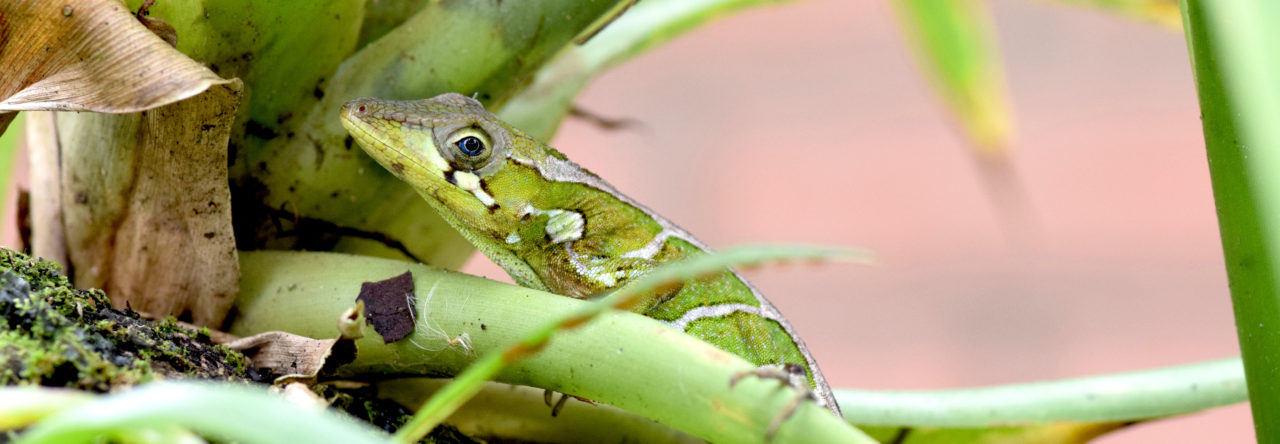
Name that lizard (this one from Miami, not Grand Cayman). Photo by J. Losos
Tennessee lizard guru Sandy Echternacht writes in to AA about the green anoles that have shown up on Grand Cayman, in response to a post from several years ago:
I also think that it is difficult or impossible to distinguish U.S. Anolis carolinensis from U.S. A. porcatus in the field since you typically don’t have live, known A. porcatus for comparison. I think that Wes Chun is correct. Fully adult male A. porcatus are bulkier than A. carolinensis and I’ve seen some with what appear to be large bilateral calcium (?) deposits between the jaw and the neck that give them a bit of the look of a bulldog. I haven’t a clue how, for these two species, to distinguish subadult males and females in general. That shoulder bar (black; often with turquoise blue spots around the edges) is present in many populations of A. carolinensis in the Florida and further north and west, so it can’t be a reliable indicator of A. porcatus.
In addition, most of the relevant research on these issues today concentrates on spectral analyses of skin and dewlap colors, sometimes comparing these to spectral characteristics of the habitat which the lizards occupy. It’s time for a little old school field work. We need detailed narrative descriptions of color AND pattern of live A. carolinensis obtained under controlled conditions of light and temperature and in the maximum green and maximum dark color phases, and of patterning in both color phases, and these data need to be representative of populations across the entire mainland range of the species. If done by multiple investigators, these studies need to employ the same methods and standards. Geographic variation is obvious. Most A. carolinensis have pink to reddish dewlaps but those in southwestern Florida are grayish or greenish, I found a small population between Corkscrew Swamp Sanctuary and Immokalee, FL with pale orange dewlaps, and some males on Oahu, HI have lilac-colored dewlaps. As noted above, the shoulder patch can be entirely absent in a population or present but in frequencies that differ among populations. In East Tennessee, animals in the maximal dark phase are very dark brown to nearly black with no patterning (except a pale venter) whereas those near Gainesville, FL are a gray with a filigree pattern that is whitish in color. The frequency of females with pale middorsal stripes varies among populations. In a part of Withlacoochee State Forest, FL and in the green phase, the color is “chalky” green, along the coast near Ft. Myers it is a beautiful emerald green, further north, as far as Tennessee, it is more of a leafy green. As important as they are, spectral studies usually don’t mention pattern at all, and are carried out only in the green phase. Further, spectral values are of little value to someone working in the field not well versed in visualizing what they mean in the context of the lizard they are holding. I say all of this despite having a friend who is heavily invested in spectral studies. With all of this variation, and without having comparable data for A. porcatus, I’m not sure that we will ever be able to identify in the field with 100% certainty whether a green anole in South Florida (or the Cayman Islands) is A. carolinensis or A. porcatus with the possible exception of a large male A. porcatus with “calcium” deposits.
But I guess I could be wrong.
- Evolution in Real Time on Lizard Island - March 23, 2025
- Spider Snags Adult Anolis osa - March 22, 2025
- An Homage to the Green Anoles of New Orleans - March 21, 2025


Skip Lazell
Are they real species? Is there a way to separate them absolutely? How about DNA? In nature they were geographically replacing allopats separated by water. Now we have moved them all over! What a terrific problem! Skip
Skip Lazell
Fourth day, no answer…. No one knows? I see a Ph.D. thesis possible here! Not me: already did that! Skip
James Stroud
A useful reference for this may be Brian Camposano’s masters thesis (available here: http://ufdc.ufl.edu/UFE0043698/00001) – p.42-45 are of particular interest for this topic.
After assessing 43 meristic and morphometric traits on specimens of both A. carolinensis (from 3 sites in northern Florida) and A. porcatus (from Cuba) Camoposano concludes, “…one introduced species, Anolis porcatus, is indistinguishable from its native counterpart, A. carolinensis…”
and
“…To attempt to distinguish A. porcatus from A. carolinensis, I used binomial logistic
regression models and DFAs. I found evidence to support characters that allowed for
differentiation between each species present in Florida. However, while there was statistical evidence supporting combinations of characters to discern A. carolinensis from A. porcatus, no such character or characters could differentiate between them with 100% accuracy in every case…”
Skip Lazell
OK, DNA next…. If that doesn’t work, synonymize. Skip
Skip Lazell
OK. I give up. Nobody knows about relevant DNA…. ‘Bye! Skip
Armando Pou
Hi Skip, ok, in my mind, this just brings up more and more questions. Pardon me if I have asked this before. What defines a species? Do geographical barriers conclusively define a species? Is it possible that A. carolinensis and A. porcatus are the same species? Strictly from a biological perspective, it would seem to me that two creatures that can mate and produce viable, fertile offspring share nearly identical DNA; or is this a completely misguided conclusion? Many animal pairings with very similar but not identical DNA produce mostly sterile offspring.